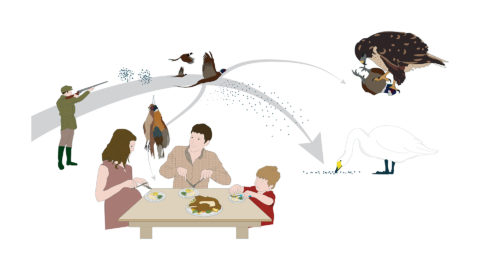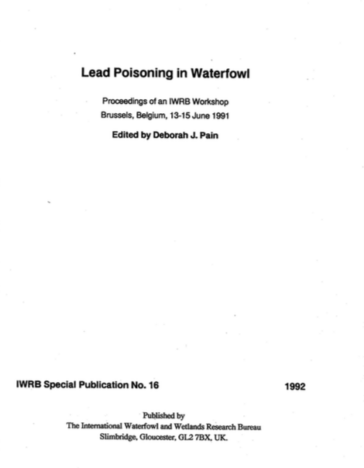
Lead poisoning in waterfowl: 30 years of progress but still an unresolved problem
-
Species
Thirty years ago today, on 13 June 1991, a major international meeting organised by our predecessor organization, International Waterfowl & Wetlands Research Bureau (now Wetlands International), convened to address how to eliminate the poisoning of waterbirds with toxic lead gunshot. Shot is deposited on the ground whenever it is used and subsequently kills when it is consumed by waterbirds.
The aim of the conference was to review the extent of the problems of lead poisoning throughout the world and identify possible solutions. It “concluded that the only effective solution to this problem, other than the cessation of hunting, was the replacement of lead shot with non-toxic alternatives.” The outcome was “the unanimous commitment of all groups represented [governments, the non-government hunting and conservation organisations], to overcome what was perceived as a serious problem for waterfowl.”[i]
That outcome – to phase out the use of lead gunshot to prevent waterfowl poisoning – has stimulated much conservation both internationally and nationally in the three decades since. For example, in the UK, the government established a Working Group later in 1991 to address the issue, leading to the introduction of legislation from 1999.
It directly influenced international conservation treaties. The UN-African-Eurasian Waterbirds Agreement (AEWA) was adopted in 1995 and adopted as one of its goals that its signatories “shall endeavour to phase out the use of lead shot for hunting in wetlands by the year 2000.” And in 2014, the Convention on Migratory Species resolved to “Phase-out the use of lead ammunition across all habitats (wetland and terrestrial) with non-toxic alternatives within the next three years …” a decision endorsed more widely by the government and non-government members of IUCN in 2016 at the World Conservation Congress. In 2017, the Environment Assembly of the United Nations Environment Programme – the world’s most senior decision-making body on environmental issues also recognised the risk of lead ammunition and the need for solutions.
Progress in phasing out lead ammunition across the globe
Some countries have made a successful transition to non-toxic hunting. For example, in the Netherlands the use of lead gunshot was prohibited in 1993, and similarly in Denmark in 1996. Such complete phase outs have been effective. Of those countries’ signatory to AEWA, in 2018, 31% reported they had fully phased out lead shot from use in wetlands, with another 12% having partially achieved this.[ii]
In early 2021, the European Parliament adopted recommendations from the EU Chemicals Agency to prohibit the use and carrying of lead gunshot in wetlands – a ban that will enter into force in February 2023. A second consultation is underway with respect of a proposal to phase out lead in other ammunition types as well as from use in fishing weights.
Lead ammunition is a continued risk
Our understanding the extent of the problem and risks have grown over these last 30 years since 1991:
- Whilst the historical focus was on the threat arising from lead gunshot deposition in wetlands, it is now known that birds inadvertently consume, and are poisoned by, shot deposited away from wetlands;
- Birds of prey and scavengers have been found secondarily poisoned following their consumption of poisoned waterbirds with population-level impacts for some threatened species;
- There is now better understanding of the fate of the thousands of tonnes of lead released annually to the soil, with awareness of its uptake into plants and domestic animals, and leaching into surface waters; and
- There is now clearer understanding of the human health impacts from the regular consumption of animals shot with lead ammunition – a particular concern for the health of children and pregnant women due to the neurotoxic effects of lead.
Continue reading about the risk of lead contamination in wetlands and society here.
Even where legislation has been adopted, there can be significant lack of compliance: for example, repeated monitoring in England has shown that over 70% of ducks continue to be illegally shot with lead gunshot[iii].

The solution is to ban all uses of toxic lead gunshot
Pioneered in Europe by Denmark and the Netherlands, the solution is simple and has been shown to be successful: a ban of all uses of toxic lead gunshot. Such a statutory restriction is administratively simple and easy to enforce. Food retailers and those that deal in game are increasingly recognising the consumer demand for food that does not contain toxic lead ammunition – and so driving change. Yet despite the attention given to this issue by the international community over thirty years, there is still much to do and progress is slow despite the ready existence of non-toxic alternatives.
Notes for editors:
- How lead gunshot poisons birds: As waterbirds such as ducks do not have teeth to grind down their plant food, they eat grit which stays in their stomachs acting as a sort of ‘liquid sand-paper’. When spent lead gunshot is ingested it is ground down and poisons the bird. Other scavenging or predatory birds such as eagles, can eat waterbirds that have lead gunshot in their tissues – the result of their being hit but not killed by lead shot. This also kills these birds – many of which already have small populations.
- IWRB: The International Waterfowl & Wetlands Research Bureau was founded in 1954 as an independent non-governmental organisation promoting the conservation and sustainable use of waterbirds and wetlands. It played an instrumental role in the creation of the Ramsar Convention on wetlands and in 1996 it became part of Wetlands International.
- The objective of the IWRB Conference: The workshop brought together more than 100 participants from 21 countries, representing experts in the field of lead poisoning, government agencies, conservation and hunting organisations, and arms and ammunition manufacturers.
[i] Pain, D.J. (ed.) 1992. Lead poisoning in waterfowl. Proceedings of an IWRB Workshop, Brussels, Belgium, 13-15 June 1991. IWRB Special Publication No. 16. 105 pp.
[ii] National Reports to AEWA’s seventh Meeting of Parties in 2018.
[iii] Cromie, R., Newth, J., Reeves, J., O’Brien, M., Beckmann, K & Brown, M. 2015. The sociological and political aspects of reducing lead poisoning from ammunition in the UK: why the transition to non-toxic ammunition is so difficult. Pp. 104-124. In: R.J. Delahay & C.J. Spray (eds.) Proceedings of the Oxford Lead Symposium. Lead Ammunition: understanding and minimising the risks to human and environmental health. Edward Grey Institute, University of Oxford, Oxford, UK.
Banner image credited to Taej Mundkur

